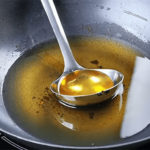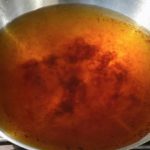To handle excess cooking oil properly, it is essential to avoid pouring it down the drain or flushing it down the toilet, as these actions can lead to pipe blockages and other issues. Instead, follow these methods for handling excess cooking oil in a responsible manner:
1. Allow the oil to cool: Before disposing of cooking oil, ensure that it has cooled completely. This will prevent any potential burns or accidents.
2. Reuse or store: If the oil is still in good condition and can be used again, consider storing it in a clean, airtight container for future use. Be sure to label the container with the type of oil and the date it was used.
3. Solidify and dispose: If you do not wish to reuse the oil, you can solidify it by placing it in the fridge or freezer. Once solidified, you can scoop it out and dispose of it in the trash. It is important to use a sealable container or bag to prevent any leakage.
4. Mix with absorbent materials: Another option is to mix the cooking oil with absorbent materials such as coffee grounds, kitty litter, or sawdust. These materials will help to soak up the oil and make it easier to dispose of. Mix the oil with the absorbent material and then dispose of it in the trash.
5. Recycle: Some areas have programs in place for recycling used cooking oil. Check with your local recycling center or municipality to see if they accept cooking oil. They will provide specific instructions on how to properly recycle it.
By following these methods, you can prevent pipe blockages and maintain a cleaner living environment. Properly disposing of excess cooking oil is not only important for your home but also for the environment.
Section 1
This is the first section of the content.
Section 2
This is the second section of the content.
Section 3
This is the third section of the content.
Section 1
This is the first section of the content.
Section 2
This is the second section of the content.
Section 3
This is the third section of the content.
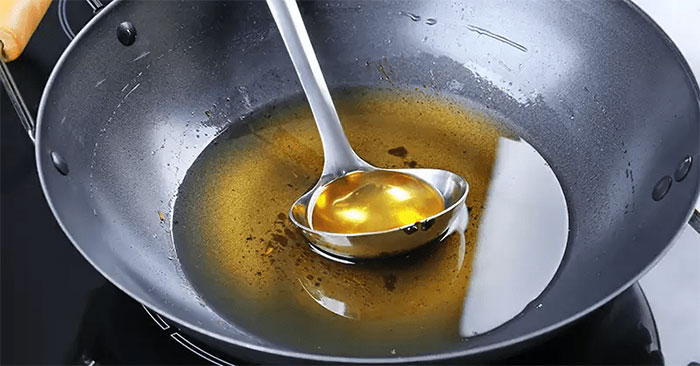
To properly dispose of excess oil, it is recommended to pour it into a bottle, can, or jar before disposing of it. This helps prevent leakage and ensures safe disposal.
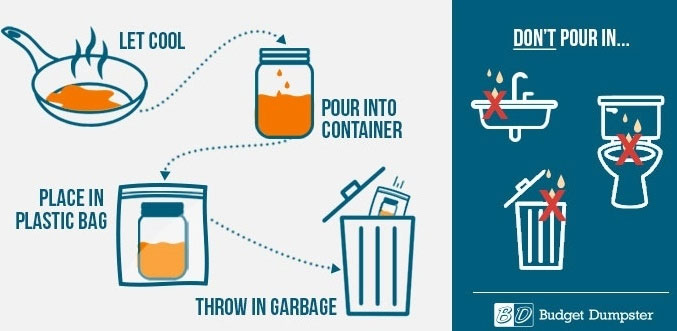
If there is a small amount of excess cooking oil, it is advisable to use oil-absorbing paper or toilet paper to soak it up before disposing of it in the trash.
Professional chef Jennifer Hill Booker recommends freezing excess cooking oil before discarding it to prevent leaks.
Did you know that used cooking oil can be recycled or reused instead of being thrown away?
Used cooking oil can be transformed into biodiesel, a renewable energy source. It can also be used as a raw material for making soap or as a lubricant for machinery. By recycling or reusing your used cooking oil, you can contribute to a more sustainable future. Check with your local recycling center or waste management facility for specific instructions on how to properly recycle or dispose of used cooking oil.
Southern Living suggests that before recycling cooking oil, ensure it is free of any food debris by thoroughly removing oil residue and leftover food particles.
Tips for Cleaning Used Oil Residue
Cleaning up used oil residue can be challenging, but with the right tools and techniques, it can be done effectively. Here are some tips to help you clean up oil residue:
- Absorb the oil: Start by using an absorbent material, such as cat litter, sawdust, or baking soda, to soak up as much of the oil as possible. Sprinkle the absorbent material over the oil spill, let it sit for a few minutes, then sweep or vacuum up the material.
- Use a degreaser: Once you have removed as much oil as possible, use a degreaser to break up the remaining oil residue. You can use a commercial degreaser or make your own by mixing equal parts dish soap and water. Apply the degreaser to the affected area, let it sit for a few minutes, then scrub with a stiff brush or sponge. Rinse with water and repeat if necessary.
- Try vinegar or baking soda: If the degreaser doesn’t fully remove the oil residue, you can try using vinegar or baking soda. Vinegar is a natural cleaning agent that can break down grease and oil. Soak a cloth or sponge in vinegar and scrub the affected area. Baking soda is also effective at absorbing oil. Sprinkle baking soda over the oil residue, let it sit for a few minutes, then scrub with a sponge or brush.
- Hot water and soap: For stubborn oil residue, you can use hot water and dish soap. Fill a bucket or sink with hot water and add a generous amount of dish soap. Dip a sponge or cloth in the soapy water and scrub the affected area. The hot water will dissolve the oil, and the soap will help loosen and remove the residue. Rinse with clean water and repeat if necessary.
- Power washing: If other methods fail, you may need to use a power washer to remove the oil residue. Follow the manufacturer’s instructions carefully to avoid damaging surfaces. Keep in mind that power washing may require more time and effort, but it can be effective for stubborn oil residue.
Cleaning up used oil residue requires time and effort, but with these tips, you can effectively remove even the toughest oil stains. Remember to follow proper safety precautions when handling and disposing of used oil and cleaning products.
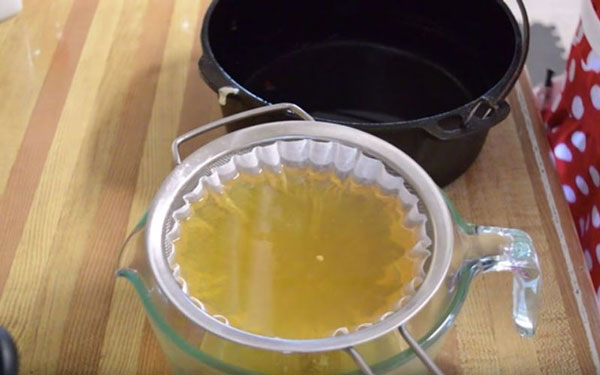
Enhance the filtration process of cooking oil by using cornstarch or cornmeal. Dissolve cornstarch in 100ml of water and gradually pour this mixture into the hot grease or oil. The starch will attract and trap any food residue present. Remove the starch using a slotted spoon, leaving behind purified oil ready for further use.
Properly storing used cooking oil is crucial for maintaining a clean and efficient kitchen. Pouring oil down the drain can lead to clogs and plumbing issues, so it is best to dispose of it responsibly. Follow these steps to store used cooking oil safely:
- Allow the cooking oil to cool: Before storing used cooking oil, let it cool completely. Hot oil can cause burns and other accidents.
- Strain the oil: To remove any food particles and debris, strain the oil through a fine-mesh sieve or cheesecloth. This prolongs the shelf life of the oil and prevents unwanted flavors from transferring to future dishes.
- Choose an appropriate container: Select a container made of a material resistant to oil, such as glass or stainless steel. Avoid plastic containers, as they can react with the oil and cause it to degrade.
- Pour the oil into the container: Carefully pour the strained oil into the chosen container, leaving some space at the top to allow for expansion as the oil cools and solidifies.
- Seal the container: Once filled with oil, seal the container tightly with a lid or cork to prevent air and moisture from spoiling the oil.
- Store in a cool, dark place: Find a cool, dark spot in the kitchen or pantry to store the container of used cooking oil. Keep it away from sources of heat, such as the stove or oven, to preserve its quality.
- Monitor the storage time: Keep track of how long you have stored the used cooking oil. Over time, it will break down and become rancid. Use the oil within three months of storing it.
When it is time to dispose of the used cooking oil, do not pour it down the drain or throw it in the trash. Check with your local recycling or waste management facility for proper disposal methods. Many cities have designated drop-off locations for recycling or safe disposal of used cooking oil. By following these steps, you can safely store and dispose of used cooking oil, protecting your plumbing and the environment.
To ensure proper storage of used cooking oil, transfer it into a glass jar and tightly seal it before refrigerating. By following these guidelines, the freshness and quality of the used oil can be maintained. Remember not to store used oil for more than three to four weeks, as it may lose its flavor and become rancid. By adhering to these simple practices, you can extend the lifespan of your used cooking oil and maximize its usability.
There are situations when it is best to avoid reusing cooking oil:
- When the oil starts to smoke: Reusing oil that has reached its smoke point can result in unpleasant flavors and potentially harmful effects on health.
- When the oil has a strong odor: Rancid oil with a foul smell can impart off-putting tastes in your food.
- When the oil is dark and murky: Oil that has become dark and cloudy due to food particles and impurities should not be reused, as it can compromise the taste and quality of dishes.
- When the oil has been used to cook fish or strong-flavored foods: Oil that has absorbed strong flavors from fish or heavily seasoned dishes can result in unpleasant tastes in future meals.
- When the oil has been used to fry battered foods: Oil used to fry battered foods can become greasy and produce an unpleasant end result due to small particles that can burn and darken the oil.
In most cases, it is best to dispose of used cooking oil rather than reusing it. Pour the oil into a sealed container and then throw it in the trash, or check if your local recycling center accepts cooking oil for proper disposal. By properly disposing of used oil, you can ensure the safety and quality of your future meals.
- If the oil has been properly filtered but still has visible dust residue, it is not recommended to reuse it.
- If the cooking oil has been filtered and stored in the refrigerator but still contains sediment at the bottom of the container, it should be discarded and not reused.
- If the used cooking oil has an unpleasant odor, it is advisable to avoid reusing it.
Dispose of excess cooking oil properly as instructed above. Always remember not to pour excess cooking oil down the drain, as it can cause clogs and damage to your plumbing system. Collect the oil in a disposable container such as a glass jar or plastic bottle, seal it tightly, and dispose of it in the trash. This ensures that the oil is disposed of safely and responsibly.
Tips for Disposing of Excess Cooking Oil
Have you ever been left with excess cooking oil after a meal and been unsure of how to dispose it properly? Well, it turns out pouring it down the drain or flushing it down the toilet is not the right way to go about it as this can cause blockages in the pipes as well as attract a range of unpleasant pests. To help you with this issue, here are some proper methods for disposing of your excess cooking oil.
Proper Edible Oil Disposal: Preserving the Environment and Safeguarding Health
Cooking oil is used to fry food. Quite often there is excess oil left over after frying and many people are unsure how to dispose of it properly.

























